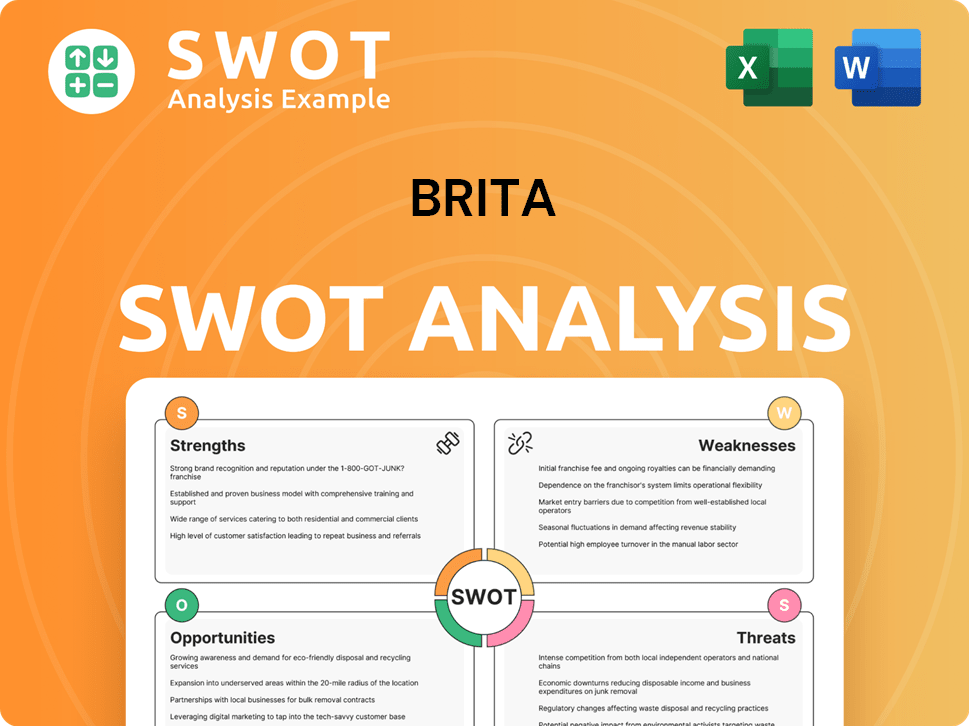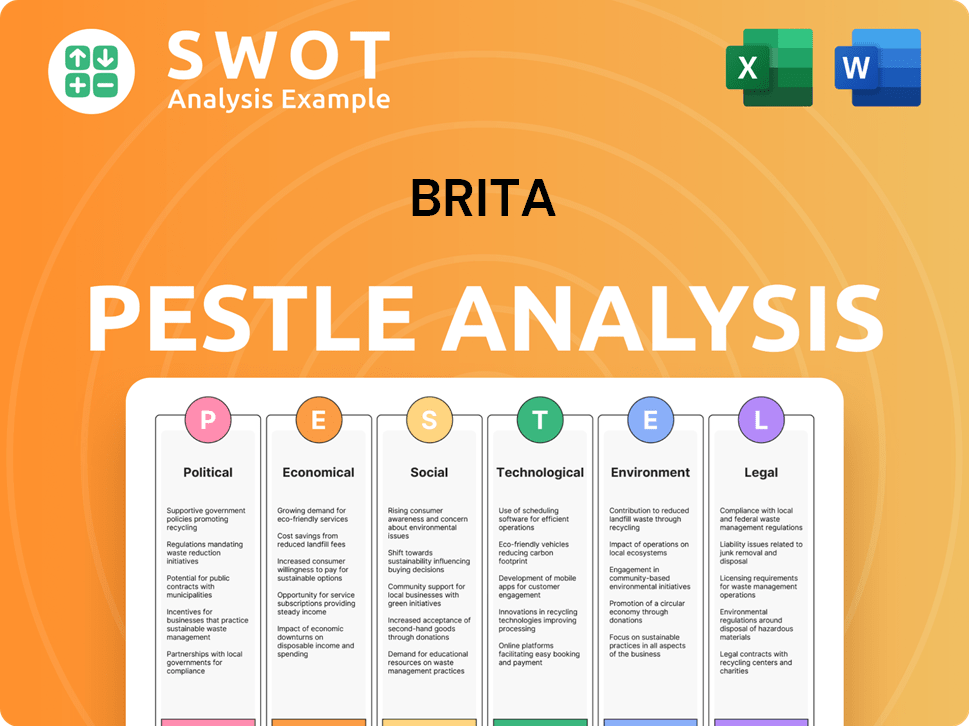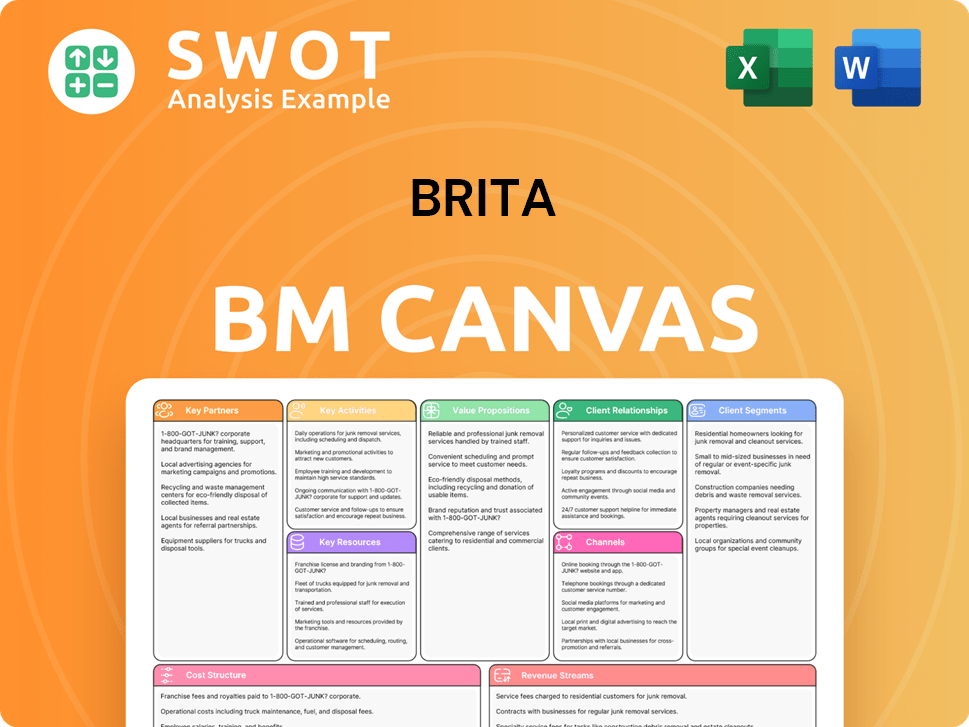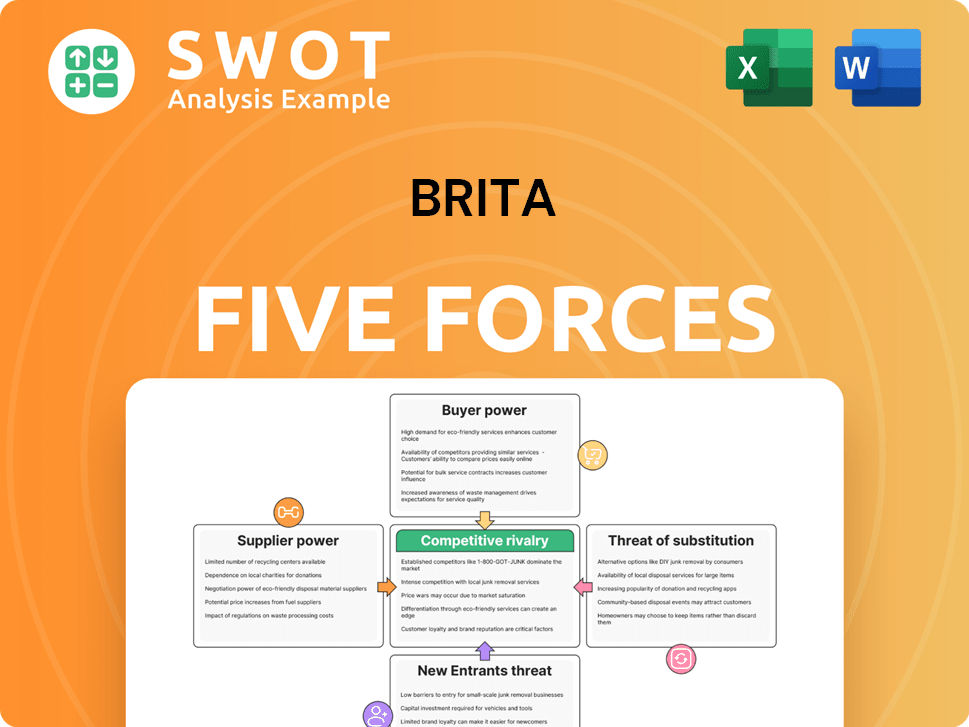Brita Bundle
Can Brita Maintain Its Dominance in the Water Filter Wars?
The global water filter industry is booming, fueled by increasing consumer awareness of water quality and a desire for sustainable hydration solutions. Brita SWOT Analysis, a household name in water filtration, has been a leader since its inception. But in a market teeming with rivals, how does Brita maintain its edge?

This article dives deep into the Brita competitive landscape, providing a comprehensive Brita market analysis. We'll identify Brita competitors, evaluate their strengths and weaknesses, and explore how Brita's competitive advantage is shaping its future. Understanding the dynamics of the water filter industry is crucial for investors and businesses alike, and this analysis offers actionable insights into this evolving sector.
Where Does Brita’ Stand in the Current Market?
The Brief History of Brita reveals its strong market position within the household water filtration sector, particularly in the pitcher and dispenser categories. Brita's core operations revolve around providing accessible and effective water filtration solutions, focusing on improving taste and reducing impurities in tap water. Their value proposition centers on offering consumers a convenient, cost-effective, and sustainable alternative to bottled water, aligning with growing consumer demand for healthier and environmentally conscious choices.
Brita's product lines primarily include gravity-fed water filter pitchers and dispensers, along with faucet-mounted filters. These products cater to a broad customer base, from individual consumers to families, emphasizing ease of use and filter efficacy. The company has largely maintained its focus on the mid-range to premium segments of the market, highlighting product design and filter performance as key differentiators.
While precise global market share figures for 2024-2025 are not readily available, Brita consistently ranks among the top brands in the water filter industry across North America and Europe. This sustained presence and brand recognition indicate a robust financial standing, though specific financial comparisons are complex due to Brita's private ownership. Brita's market analysis shows particularly strong presence in countries like Germany, the United Kingdom, and the United States, where brand loyalty and established distribution channels contribute to its market leadership.
Brita's competitive advantages include strong brand recognition, a wide distribution network, and a focus on product innovation. They have a well-established reputation for quality and reliability, which fosters customer loyalty. Their ability to adapt to changing consumer preferences and environmental concerns also strengthens their position in the water filter industry.
Challenges include intense competition from other brands, such as PUR, and the need to continually innovate to maintain market share. Changes in consumer behavior and the emergence of new filtration technologies also pose challenges. Furthermore, fluctuations in raw material costs and supply chain disruptions can impact profitability.
Brita continues to innovate with new filter designs and product features to improve user experience and filtration performance. They focus on sustainable practices, such as using recyclable materials and developing long-lasting filters. Recent product launches include advanced filtration systems that target specific contaminants.
Brita utilizes a multi-channel distribution strategy, including retail stores, online platforms, and partnerships with major retailers. Their marketing campaigns emphasize the benefits of clean, filtered water and promote their brand's commitment to sustainability. They often collaborate with influencers and health experts to enhance brand awareness.
Brita maintains a significant market share in the water filter industry, particularly in the pitcher and dispenser segments. The company's financial performance is strong, supported by brand recognition and distribution networks. Brita's customer satisfaction ratings are generally high, reflecting the quality and effectiveness of their products.
- Brita's market share in North America and Europe is consistently among the top brands.
- The company's focus on product innovation and sustainability drives customer loyalty.
- Brita's distribution channels include retail stores and online platforms.
- Brita's marketing campaigns focus on the benefits of clean, filtered water.
Brita SWOT Analysis
- Complete SWOT Breakdown
- Fully Customizable
- Editable in Excel & Word
- Professional Formatting
- Investor-Ready Format

Who Are the Main Competitors Challenging Brita?
The Growth Strategy of Brita is significantly influenced by the competitive landscape within the water filtration market. Understanding the key players and their strategies is crucial for assessing Brita's market position and future prospects. This analysis involves examining both direct and indirect competitors, evaluating their strengths and weaknesses, and considering their impact on Brita's market share and overall performance. A thorough Brita market analysis reveals the dynamics of this competitive environment.
Brita's competitive advantage hinges on its ability to differentiate itself through product innovation, effective marketing, and strong distribution channels. Analyzing the competitive landscape helps identify opportunities for Brita to strengthen its position and address potential threats. This includes understanding consumer preferences, technological advancements, and evolving market trends within the water filter industry.
The Brita competitive landscape is multifaceted, with various companies vying for market share. Direct competitors offer similar products, while indirect competitors provide alternative solutions to consumers' water needs. The competitive dynamics are shaped by factors such as pricing, product features, brand reputation, and distribution networks. A detailed examination of Brita's main competitors is essential for strategic decision-making.
PUR, owned by Helen of Troy, is a major direct competitor, offering similar water filtration products. They often compete directly with Brita on price and filter technology. The competition between Brita and PUR is intense, particularly in the filter pitcher and faucet mount categories.
ZeroWater is another direct competitor, known for its five-stage filtration system. ZeroWater targets consumers seeking ultra-pure water by claiming to remove nearly all total dissolved solids (TDS). This focus on water purity gives ZeroWater a competitive edge in a specific market segment.
Refrigerator water filter manufacturers, such as Whirlpool and GE Appliances, offer built-in filtration systems. These systems provide convenience, which can impact Brita's market share. The convenience factor makes these a significant indirect competitor.
The bottled water industry, including Nestlé Waters and Coca-Cola (Dasani, Smartwater), poses indirect competition. Consumers often choose bottled water over filtered tap water. The convenience and marketing efforts of bottled water brands influence consumer choices.
Emerging players in home appliances and health technology could introduce innovative filtration solutions. Smart home integration and advanced filtration technologies may challenge Brita. These new entrants could disrupt the market with new product offerings.
The water filter industry is influenced by consumer preferences, technological advancements, and sustainability concerns. Brita must adapt to these trends to maintain its competitive position. Understanding these dynamics is crucial for strategic planning and innovation.
Brita's market position is influenced by its ability to compete with both direct and indirect competitors. The company's strengths include brand recognition and a wide distribution network. However, it faces challenges from competitors with innovative technologies and strong marketing strategies. A thorough Brita's strengths and weaknesses analysis is essential.
- PUR vs. Brita: PUR often competes directly on price and product features, making it a key rival.
- ZeroWater's Niche: ZeroWater's focus on ultra-pure water targets a specific consumer segment.
- Bottled Water Impact: The bottled water industry provides a convenient alternative, influencing consumer choices.
- Technological Advancements: New technologies and smart home integration pose future challenges.
Brita PESTLE Analysis
- Covers All 6 PESTLE Categories
- No Research Needed – Save Hours of Work
- Built by Experts, Trusted by Consultants
- Instant Download, Ready to Use
- 100% Editable, Fully Customizable

What Gives Brita a Competitive Edge Over Its Rivals?
Understanding the Brita competitive landscape involves recognizing its key advantages. These advantages have helped the company maintain a strong position in the water filter industry. Brita's success can be attributed to a combination of factors that set it apart from its competitors.
The company's competitive edge stems from its strong brand recognition and extensive distribution networks. Brita has cultivated a brand synonymous with water filtration, building consumer trust over many years. This brand loyalty translates into a sustainable competitive advantage. Furthermore, the widespread availability of Brita products in major retail outlets and online platforms ensures broad market reach.
Another critical element is Brita's focus on continuous product development and innovation in filter technology. Brita consistently invests in research and development to improve filter performance and product design. This commitment to innovation helps Brita stay ahead in the water filter market, addressing various water quality concerns.
Brita's brand name is widely recognized, with high consumer trust in its product quality. This strong brand equity translates into significant customer loyalty. The company's marketing campaigns emphasize health, taste improvement, and environmental benefits, reinforcing its position as a reliable choice for water filtration.
Brita benefits from extensive distribution channels, ensuring broad accessibility. Its products are readily available in major retailers, supermarkets, and online platforms globally. This widespread distribution network allows Brita to reach a large consumer base, supporting its market share.
Brita leverages proprietary filter technology that addresses various water quality concerns. The company consistently invests in research and development to enhance filter performance and product design. This commitment to innovation allows Brita to adapt to evolving consumer demands and maintain a competitive edge.
Brita is increasingly focusing on sustainability, which enhances its brand image. This includes efforts to reduce plastic waste and promote reusable products. These initiatives align with growing consumer demand for environmentally friendly products, boosting brand appeal.
Brita's competitive advantages include strong brand equity, extensive distribution, and continuous product innovation. These elements contribute to its sustained market presence. Understanding these factors provides insight into Brita's strategic positioning within the water filter industry.
- Brand Recognition: High consumer trust and loyalty.
- Distribution: Wide availability through various channels.
- Innovation: Continuous improvement in filter technology.
- Sustainability: Focus on environmentally friendly practices.
Brita Business Model Canvas
- Complete 9-Block Business Model Canvas
- Effortlessly Communicate Your Business Strategy
- Investor-Ready BMC Format
- 100% Editable and Customizable
- Clear and Structured Layout

What Industry Trends Are Reshaping Brita’s Competitive Landscape?
The water filtration industry is currently experiencing significant shifts, driven by increasing consumer awareness of water quality, growing sustainability concerns, and rapid technological advancements. These trends present both challenges and opportunities for companies like the one that produces water filtration products. Factors such as evolving consumer preferences and the emergence of new competitors are reshaping the competitive landscape. A comprehensive understanding of these dynamics is crucial for strategic planning and sustained market success.
The future outlook for the water filter industry is influenced by regulatory changes, such as stricter drinking water standards, and consumer demand for eco-friendly products. The company's ability to adapt to these trends and capitalize on emerging opportunities will be key to maintaining its competitive advantage. Analyzing the competitive landscape, including the company's strengths and weaknesses, is essential for developing effective strategies and ensuring long-term growth.
The water filter industry is seeing increased consumer awareness about water quality issues, leading to higher demand for filtration products. Sustainability is a major trend, with consumers favoring eco-friendly and reusable products. Advancements in filtration technology, such as smart water pitchers, are also driving innovation and market growth.
New competitors entering the market with innovative technologies or lower prices pose a threat to established brands. Consumer preferences may shift towards more integrated home water solutions, such as whole-house filtration systems. Declining demand for traditional pitcher filters due to improvements in municipal water quality could also impact sales.
Expanding into emerging markets where water quality is a concern can drive revenue growth. Developing new product lines that target specific contaminants or offer enhanced features presents another opportunity. Strategic partnerships with appliance manufacturers or smart home platforms can also boost market presence and innovation.
The company should focus on offering technologically advanced and integrated solutions while emphasizing its sustainability credentials. Continuous innovation and adaptation to changing consumer needs are crucial for maintaining a competitive edge. Analyzing the Brita competitive landscape and adapting to market dynamics will be essential for long-term success.
To thrive, the company must leverage its brand recognition and adapt to evolving market demands. This includes innovation in product design, expansion into new markets, and strengthening sustainability initiatives. Understanding the Brita market analysis and the strategies of Brita competitors will be critical for success.
- Focus on product innovation, such as smart water filters and advanced filtration technologies.
- Expand into high-growth markets, particularly those with significant water quality concerns.
- Enhance sustainability efforts by using eco-friendly materials and reducing plastic waste.
- Strengthen distribution channels and explore strategic partnerships with retailers and technology providers.
Brita Porter's Five Forces Analysis
- Covers All 5 Competitive Forces in Detail
- Structured for Consultants, Students, and Founders
- 100% Editable in Microsoft Word & Excel
- Instant Digital Download – Use Immediately
- Compatible with Mac & PC – Fully Unlocked

Related Blogs
- What are Mission Vision & Core Values of Brita Company?
- What is Growth Strategy and Future Prospects of Brita Company?
- How Does Brita Company Work?
- What is Sales and Marketing Strategy of Brita Company?
- What is Brief History of Brita Company?
- Who Owns Brita Company?
- What is Customer Demographics and Target Market of Brita Company?
Disclaimer
All information, articles, and product details provided on this website are for general informational and educational purposes only. We do not claim any ownership over, nor do we intend to infringe upon, any trademarks, copyrights, logos, brand names, or other intellectual property mentioned or depicted on this site. Such intellectual property remains the property of its respective owners, and any references here are made solely for identification or informational purposes, without implying any affiliation, endorsement, or partnership.
We make no representations or warranties, express or implied, regarding the accuracy, completeness, or suitability of any content or products presented. Nothing on this website should be construed as legal, tax, investment, financial, medical, or other professional advice. In addition, no part of this site—including articles or product references—constitutes a solicitation, recommendation, endorsement, advertisement, or offer to buy or sell any securities, franchises, or other financial instruments, particularly in jurisdictions where such activity would be unlawful.
All content is of a general nature and may not address the specific circumstances of any individual or entity. It is not a substitute for professional advice or services. Any actions you take based on the information provided here are strictly at your own risk. You accept full responsibility for any decisions or outcomes arising from your use of this website and agree to release us from any liability in connection with your use of, or reliance upon, the content or products found herein.